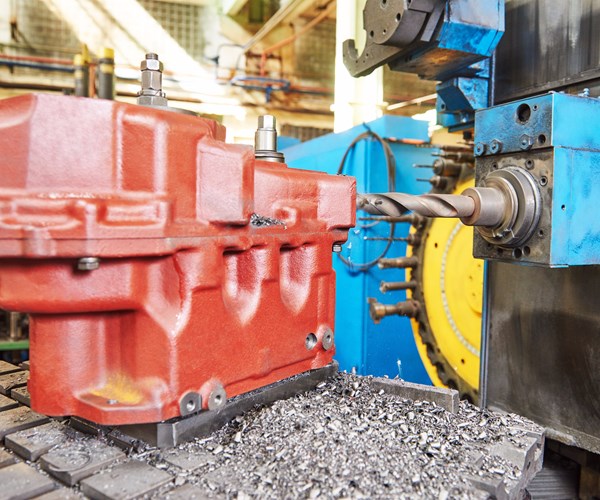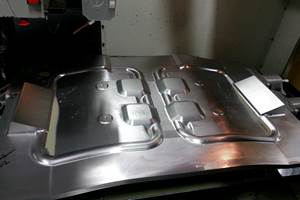Buying an HMC: What Makes Horizontal Machining Centers Different
Is it time to move up to a horizontal machining center? Let’s consider some of the structural, application and design factors that differentiate HMCs from vertical machines.
Share






This blog post is adapted from an article by Barry Rogers which appeared in the May edition of the Machine/Shop print supplement to 91±¬ÁĎÍř.
In general, shops should consider using an HMC for prismatic parts on which multiple sides or surfaces must be machined. Good examples are valve bodies or aircraft components. Typical applications for an HMC include high production volumes, parts smaller in size or jobs with longer run times. That’s not to say flat or plate stock cannot be machined on an HMC, because it can. However, this type of work must overcome some minor challenges of gravity by using appropriate fixturing. In short, horizontals can offer more flexibility than vertical machines.
The first thing that jumps out at anyone considering buying an HMC is the cost. HMCs typically have three times the purchase cost of a VMC: around $375,000, compared to $15,000 for the average VMC. Notice that I didn’t say three times the cost, but three times the purchase cost. You can easily spend $1 million if you want to purchase the most technologically advanced HMC available on the market today, including desirable options and accessories.
Why Buy a Horizontal?
The simple answer is productivity and profit. Horizontals can easily do three times the work of a comparable VMC. This assertion assumes that the workload to keep the machine busy is available. Without question, you can get more done in far less time using an HMC. With the increase in production, shop throughput is greatly improved. Because multiple operations can be done in a single setup on an HMC, less work in process must move around the shop, increasing efficiency.
An HMC can readily replace three to four verticals in many applications. This means one HMC operator can do the work of three VMC operators, thus reducing labor costs. While the monthly finance payment for an HMC may be $4,800 higher than that for a VMC, the monthly labor cost for one HMC may be $7,200 less than that for the same amount of production on VMCs. Also, because HMCs usually have more associated automation, the operator can devote less attention to it, enabling him or her to run another cell, operate other equipment or perform inspection.
Spindle Utilization
Making money on any CNC machine requires keeping the spindle running so that it is making chips with the least amount of operator intervention. A survey conducted by university researchers found that, “on average, VMC utilization, as measured by spindle run times, is 25 percent. HMC utilization is routinely 85 percent.” A shop proficient with its VMCs may have 30 to 35 percent utilization, yet this is still substantially below the utilization rate of an HMC.
In a typical eight-hour shift, the HMC cuts for about seven hours, whereas the VMC cuts for about two hours a shift. In a five-day week, the HMC gets 35 more hours a week of cutting time if it runs another shift a day, and more yet if operates six days a week.) Running only one shift, the HMC’s total overall added chip-cutting time can exceed 1,200 hours a year. The added cost of the horizontal almost becomes insignificant, provided you have the work to keep the machine fully loaded.
Flipping Parts
Whenever the operator must open the door of a VMC to load or unload the part, remove chips, perform in-process quality checks, or flip the part, the spindle must be stopped. If this part requires machining on six sides, the operator must move the part a total of seven times (load, reposition five times, unload). When the same part is being machined on an HMC, the operator touches the part only three times (load, reposition, unload). Productivity and efficiency is obviously improved. In addition, with an automatic pallet changer, the operator can handle these steps while the spindle continues cutting the part on the pallet inside the workzone. Improved quality may also result, because the HMC requires less operator intervention, which reduces the chances of loading errors or other missteps.
Machine Design Considerations
There has been a long-standing debate about whether box ways or linear guideways are better. When discussing VMCs, one could argue there isn’t enough difference to make that choice matter. It’s a different situation with HMCs. On HMCs, linear guideways have proven to be better for higher axis-travel speeds on materials such as aluminum because the acceleration and deceleration rates can be faster. As a result, cycle times can be reduced significantly. Some linear-guide HMCs reach 1G acceleration without sacrificing machine rigidity and without generating excess heat.
However, box ways can be better for certain HMC applications. Although HMCs with box ways have slower maximum programmable feed rates, performance is improved for operations in which high cutting forces are likely to be encountered. Box ways are recommended for heavy cuts in tough materials such as titanium, super alloys and tool steel. HMCs with box ways will deliver superior finishes, even in the heavier cuts in tough materials. The way the spindle head is constructed on an HMC is generally very rigid. This design resists deflection from cutting forces, thus enabling a heavier chip load and promoting longer tool life. Some HMCs with larger work envelopes have dual Y-axis ballscrews to support the proportionately greater weight of the Y and X axes.
HMCs are built for rigidity, so they tend to be much heavier than VMCs of the same size. (The average 40-by-20-inch VMC might weigh 16,000 pounds, whereas an HMC of the same size might weigh more than 40,000 pounds.) Because of the greater weight of an HMC, the foundation for this type of machine is more critical than for a VMC. The foundation must meet the HMC builder’s specification, and the machine must be properly placed and tied down. This prevents the machine from “bouncing around” during heavy cuts.
Compare machine specs from thousands of horizontal machining centers for free at .
Find more insights about acquiring a new machining center by visiting the Techspex Knowledge Center, “.”
Related Content
6 Variations That Kill Productivity
The act of qualifying CNC programs is largely related to eliminating variations, which can be a daunting task when you consider how many things can change from one time a job is run to the next.
Read More4 Rules for Running a Successful Machine Shop
Take time to optimize your shop’s structure to effectively meet demand while causing the least amount of stress in the shop.
Read More4 Tips for Staying Profitable in the Face of Change
After more than 40 years in business, this shop has learned how to adapt to stay profitable.
Read MoreHow to Mitigate Risk in Your Manufacturing Process or Design
Use a Failure Mode and Effect Analysis (FMEA) form as a proactive way to evaluate a manufacturing process or design.
Read MoreRead Next
How I Made It: Dennis Rymanowski
Dennis Rymanowski has worked at NSH USA for 60 years, with his passion for manufacturing living alongside his passion for his family’s polka band.
Read MoreA New Frontier in Surface Finish Control
What if your machine tool could measure surface roughness as it cuts? This article explores how in-process metrology is advancing from concept to reality, enabling real-time feedback, immediate detection of anomalies and new levels of control over surface quality. Discover the technologies making this possible.
Read More





















